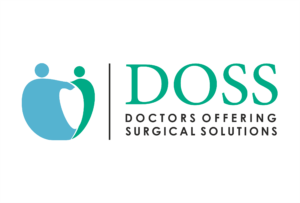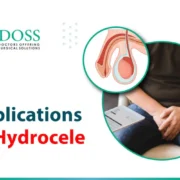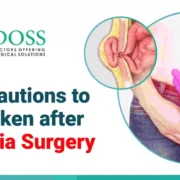Difference between Hernia and Hydrocele
Blog
When it comes to understanding medical conditions, clarity is key. Often, symptoms that appear similar can lead to a mix-up in identifying the condition correctly.
Hernia and hydrocele are two such conditions that share a common symptom – swelling in the groin area.
However, their similarities end there. Through this blog, we aim to elucidate the distinct differences between the two, focusing on their treatment aspects in a comprehensive yet simple language.
What is a Hernia?
A hernia is essentially a structural failure where internal organs or fatty tissue find a weak spot or opening in the muscle wall and protrude through it.
These weak spots can be pre-existing due to congenital reasons or can develop over time with activities that increase intra-abdominal pressure, such as heavy lifting, persistent coughing, or even obesity.
Differentiating Between Hernia Types
The inguinal hernia is the star of the hernia family, taking the lead as the most commonly encountered type. It makes its appearance in the groin area, where the abdominal contents push into a canal that usually allows the testicles to descend before birth in men.
Umbilical hernias play a different tune, emerging around the navel, while hiatal hernias have an internal stage, occurring when part of the stomach juts into the thorax.
What is Hydrocele?
The narrative of a hydrocele is quite different. It doesn’t involve organs playing a game of escape but rather fluid taking center stage in the scrotum, leading to swelling. The fluid, typically secreted and absorbed by the scrotum lining, finds a balance disrupted, resulting in accumulation.
Hydrocele: The Occurrence and Implications
Common in newborns due to the body’s adaptation post-birth, hydroceles in adults can arise from trauma, infection, or even systemic conditions that cause fluid imbalance. It’s a scrotal swelling that’s generally isolated from the abdominal cavity, unlike a hernia.
Distinguishing the Symptoms
The first step in distinguishing a hernia from a hydrocele is recognizing the symptoms.
Hernia Symptoms:
- Visible Bulge: One of the most tell-tale signs of a hernia is a bulge or lump in the groin or abdominal area. This bulge may become more pronounced when standing up, coughing, or straining, and might disappear or diminish when lying down.
- Pain and Discomfort: The bulge is not just a visual symptom; it can cause a range of uncomfortable sensations. Some individuals describe it as a sharp, searing pain that is triggered or worsened by any movement that puts pressure on the affected area, such as lifting heavy objects. For others, it’s a persistent dull ache that suggests something isn’t right within the groin or abdominal region.
- Sensation of Heaviness or Pressure: Often accompanying the bulge is a feeling of heaviness or dragging in the groin, which might be attributed to the organ protruding into the muscle wall.
- Alteration in Bulge with Posture or Activity: Notably, the appearance and discomfort associated with the hernia may fluctuate based on the body’s position or physical activity.
Related Read: Do Hernia Symptoms Differ Between Men and Women?
Hydrocele Symptoms:
- Swelling in the Scrotum: The hallmark of a hydrocele is an increase in size of the scrotum, which is caused by the accumulation of fluid. This swelling is usually smooth and balloon-like, varying in size.
- Feeling of Heaviness: Men with a hydrocele may notice a sensation of heaviness or fullness in the scrotum due to the fluid accumulation.
- Painless Swelling: Unlike hernias, hydroceles are generally not painful. Discomfort, if present, is more likely due to the size and weight of the swelling rather than pain from the condition itself.
- Consistency of Swelling: The swelling from a hydrocele is typically consistent; it does not fluctuate much with body position or activity, unlike the bulge of a hernia.
Examining the Causes
The origins of these conditions are as different as their symptoms.
Causes of Hernia:
- Congenital weakness at birth
- Straining and heavy lifting
- Excessive coughing
- Obesity
- Poor nutrition
Causes of Hydrocele:
- Congenital presence (common in newborns)
- Inflammation or injury to the scrotum
- Infection in the scrotum or a testicle
Treatment Options
When it comes to treatment, both conditions may require surgery, but the approaches and urgencies differ.
Treating Hernia:
Surgery is the only effective treatment for a hernia. The procedure, called a herniorrhaphy or hernioplasty, involves pushing the protruding organ back into place and repairing the weakened muscle area. In some cases, mesh is used to strengthen the repair.
The urgency of surgery for a hernia depends on the size, the pain level, and the risk of complications, such as strangulation of the organ, which can be life-threatening.
Treating Hydrocele:
In contrast, a hydrocele might not always need treatment if it’s asymptomatic and small. However, if it’s large and causing discomfort or embarrassment, surgery called hydrocelectomy can be performed to remove the fluid-filled sac.
This is a straightforward procedure with a quick recovery time.
In some cases, non-surgical treatments may also help manage a hydrocele. Learn more about hydrocele treatment without surgery and explore your options before considering surgery.
Struggling with a hernia or hydrocele? Don’t wait—get expert care from Dr. Neeraj Rayate, the best hernia surgeon in Pune.Whether it’s a hernia that needs immediate attention or a hydrocele causing discomfort, Dr. Rayate offers advanced surgical solutions for a quick and safe recovery. Book your consultation today for personalized, top-tier care!
Pediatric Considerations
In infants, both conditions can be present at birth. Hernias in babies may resolve on their own as the abdominal muscles strengthen. However, if a hernia is large or causing problems, surgery is recommended to prevent complications.
Hydroceles in infants often disappear without treatment within the first year of life. If a hydrocele persists, it may require surgery to prevent further issues.
Understanding Surgical Terms
Let’s demystify some medical jargon often heard in connection with these conditions:
- Herniotomy: This term refers to the surgical incision into a hernia sac.
- Hernioplasty: The repair of the hernia defect by suturing the muscle layer.
- Hydrocelectomy: The surgical removal of a hydrocele.
Adult Diagnosis and Management
In adults, distinguishing between hernia and hydrocele is vital because their management can significantly impact quality of life. A clinical examination and sometimes an ultrasound will aid in the accurate diagnosis. It’s also not uncommon for an adult to have both conditions simultaneously, which necessitates a tailored approach to treatment.
The Bottom Line
Understanding the differences between hernia and hydrocele is critical. Both can have similar presentations but require different management strategies. It’s important not to self-diagnose based on symptoms alone. If you notice swelling or a bulge in the groin area, seek medical advice for proper diagnosis and treatment.
A hernia can be a serious condition if left untreated, potentially leading to life-threatening complications. A hydrocele, while less dangerous, can still cause significant discomfort and may require intervention for relief.
Wrapping Up
It’s important to watch out for the signs of both hernia and hydrocele. Early detection and treatment are the keys to a better outcome.
If you’re unsure about the symptoms or have any concerns, it’s best to consult with a doctor Remember, accurate diagnosis is the cornerstone of effective treatment, and no two patients are the same.
Your healthcare journey is unique, and understanding the nuances of these conditions will ensure you are on the right path to health and well-being.
Please remember, this blog is for informational purposes only and is not a substitute for professional medical advice, diagnosis, or treatment.
Always seek the advice of your physician or other qualified health providers with any questions you may have regarding a medical condition. Consult experts at DOSS India,leading hernia clinic in pune for personalized care.
Must Read : What is the difference between appendix and hernia?


 +919011100010
+919011100010 

















